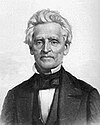Christians (Stone Movement)
The Christians (Stone Movement) were a group arising during the Second Great Awakening of the early 19th century.
[2]: 72, 73 He was unable to accept the Calvinistic doctrines of total depravity, unconditional election and predestination.
The defining event of the Stone wing of the movement was the publication of Last Will and Testament of The Springfield Presbytery, at Cane Ridge, Kentucky, in 1804.
The Last Will is a brief document in which Stone and five others announced their withdrawal from Presbyterianism and their intention to be solely part of the body of Christ.
[4] The writers appealed for the unity of all who follow Jesus, suggested the value of congregational self-governance, and lifted the Bible as the source for understanding the will of God.
They denounced the divisive use of the Westminster Confession of Faith,[5]: 79 and adopted the name "Christian" to identify their group.
"[6]: 190 [7]: 68 The cornerstone for the Stone movement was Christian freedom, which led them to a rejection of all the historical creeds, traditions and theological systems that had developed over time and a focus on a primitive Christianity based on the Bible.
[7]: 104 Members of the Stone movement believed that only a unified Christianity based on the apostolic church, rather than a country or any of the existing denominations, could lead to the coming of the millennium.
[8]: 6 For the Stone movement, this had less to do with eschatological theories and more about a countercultural commitment to live as if the kingdom of God were already established on earth.
[8]: 6, 7 This apocalyptic perspective or world view led many in the Stone movement to adopt pacifism, avoid participating in civil government, and reject violence, militarism, greed, materialism and slavery.
[9]: 28 [10]: 116–120 [11]: 212 [12]: xxi [13]: xxxvii This was formalized at the High Street Meeting House in Lexington, Kentucky with a handshake between Barton W. Stone and "Raccoon" John Smith.
[10]: 116 A preliminary meeting of the two groups was held in late December 1831, culminating with the merger on January 1, 1832.
[5]: 153–154 Many believed the union held great promise for the future success of the combined movement, and greeted the news enthusiastically.


